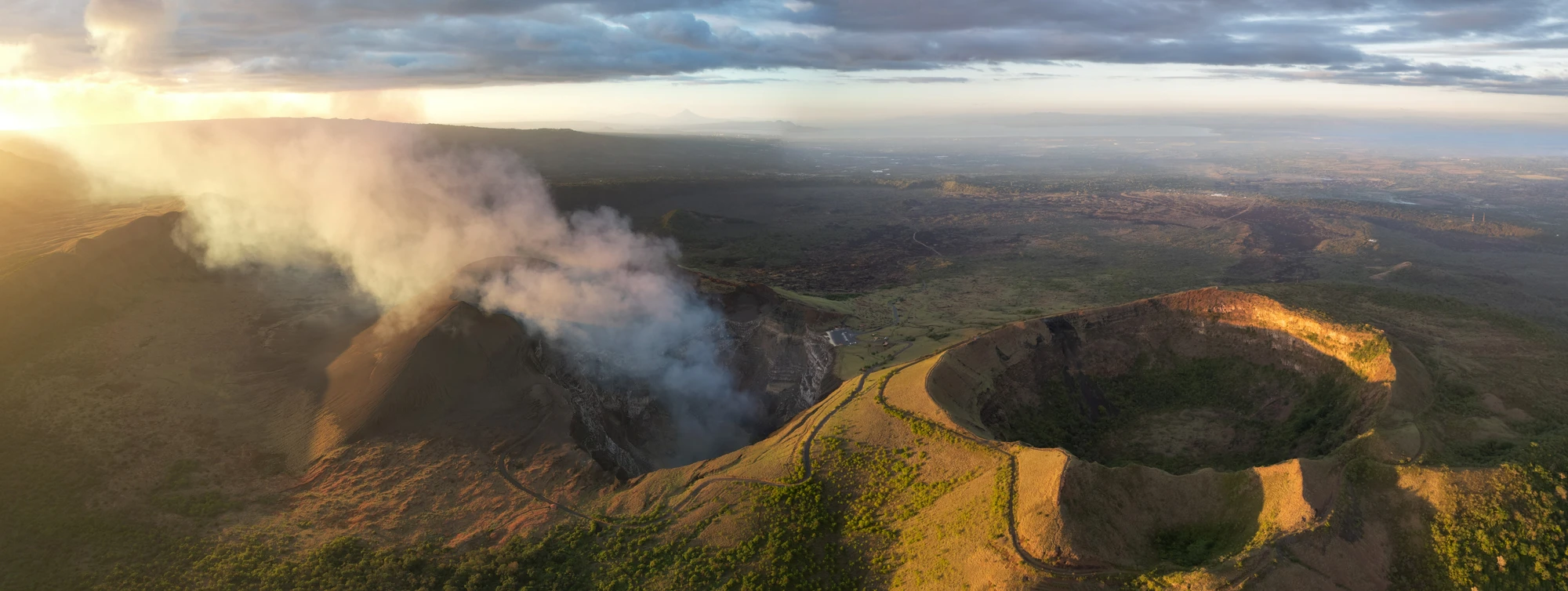Edge of Fire: Standing on the Crater Rim at Masaya Volcano
A short, dramatic encounter with an active crater—best timed at dusk for glow and atmosphere
Photo by Unknown
Shutterstock (ID: 2251204571)
You arrive at Masaya as the light is thinning. A wind from the crater smells of sulfur and iron; it carries the steady, low breath of an active earth. From the rim, the Santiago crater sits like a sleeping animal that will not be ignored—steam and gas rising in broad white curtains, rocks rimed with mineral crusts that glitter where the sun still touches them. Visitors lean against the low guardrail, cameras hunched like binoculars; the ground hums beneath their shoes, a subtle reminder that this place is alive.
Trail Wisdom
Go at dusk for the glow
Plan to arrive 45–60 minutes before sunset to catch the changing light and possible crater glow; guided night visits are safest if you want after-dark views.
Watch the wind and gases
Check with park rangers about wind direction and gas levels—if you have respiratory issues, avoid downwind viewpoints or skip the close rim entirely.
Bring a face covering
Fine volcanic dust and sulfurous fumes make a lightweight mask or bandana useful for comfort and camera lenses.
Combine the visit locally
Pair the crater with the Masaya artisan market or Catarina viewpoint to make a half- or full-day cultural loop.
Local Knowledge
Hidden Gems
- •Catarina viewpoint for colorful hill vistas and twin lagoons
- •Small pottery studios in San Juan de Oriente where artisans work by hand
Wildlife
white-tailed deer at dawn in surrounding scrub, various raptors and kestrels circling thermal updrafts
Conservation Note
The park balances visitor access with monitoring of gas emissions and fragile habitats—stick to marked paths, minimize smoke and noise, and support local artisans to reinforce community stewardship.
The Masaya area has been significant to local populations for centuries; Spanish chroniclers noted volcanic activity in the 16th century, and the volcano has long featured in indigenous stories and rituals.
Seasonal Guide
spring
Best for: clear skies, artisan markets, short hikes
Challenges: cooler evenings, possible smoky haze
Spring (March–May) still lies in the dry season—expect good visibility and comfortable daytime temperatures, with cooler winds on the rim at night.
summer
Best for: lush surrounding landscapes, fewer tourists mid-week, wildlife activity
Challenges: heavy rain in afternoons, slick trails and muddy roads
Summer months (June–August) fall in the wet season—afternoon downpours are common and can reduce crater visibility; mornings are often best.
fall
Best for: dramatic cloudbacks, fewer crowds, good sunsets
Challenges: rain during the wet season tail, variable access after storms
Fall (September–November) can bring a mix of wet and dry conditions; late fall moves toward clearer skies and improved crater viewing.
winter
Best for: clear, dry air, nighttime crater glow, easy day trips
Challenges: cooler winds at night, higher visitor numbers in peak months
Winter (December–February) is peak dry season—excellent visibility and high chance of good crater glow at dusk, but expect more visitors and cooler rim winds.
Photographer's Notes
What to Bring
Closed-toe hiking shoesEssential
Protects feet from abrasive volcanic rock and provides traction on gravel and paved surfaces.
Light wind shellEssential
Wind and cooler temperatures on the rim make a packable shell useful, especially at dusk.
Reusable water bottle (1–2 L)Essential
Hydration is essential in the dry heat and on exposed rim viewpoints.
Face mask or bandanaEssential
Helps with sulfurous fumes and volcanic dust, and protects camera gear from grit.
Common Questions
Do I need a guide to visit Masaya Volcano?
No—many visitors drive to the crater rim independently—but guided tours are recommended for night visits and for real-time safety updates about gas emissions.
Is it safe to breathe near the crater?
Air quality varies; sulfurous gases can be hazardous for people with respiratory issues. Always check with park rangers and avoid downwind areas if you have asthma or heart conditions.
How long should I plan for a visit?
Allocate 2–4 hours to include travel, time at multiple viewpoints, and possibly a short trail or a stop at the nearby artisan market.
Can I see molten lava at Masaya?
Visible molten lava is occasional; more commonly you’ll see fumarolic activity and, at times, a distant orange glow at night when the crater is active. Never lean over barriers to try to see more closely.
Are there park fees or permits?
Yes—Masaya Volcano is inside a national park with an entry fee and ranger oversight; pay at the park entrance and follow posted safety rules. Fees and hours can change, so check current info before you go.
What else can I combine with a Masaya visit?
Pair the crater with stops at the Masaya artisan market, the Catarina viewpoint, nearby colonial towns like Granada, or short hikes on marked park trails to extend the day.
What to Pack
Water bottle, light wind shell, closed-toe shoes, face mask — hydration, warmth, foot protection and dust/gas defense are essential.
Did You Know
Masaya Volcano National Park was established in 1979 and covers approximately 54 square kilometers, preserving both active craters and surrounding volcanic landscapes.
Quick Travel Tips
1) Check park hours and ranger advisories before arriving; 2) Park at the rim for walkable viewpoints; 3) Bring small cash for park fees and local crafts; 4) Avoid visiting in mid-afternoon rainy season storms.
Local Flavor
Masaya’s artisan markets and nearby pottery towns make excellent cultural bookends to a crater visit; try local dishes like vigorón at a market comedor and pick up a hand-thrown piece from San Juan de Oriente to support local artisans.
Logistics Snapshot
Drive time: ~30–60 minutes from Managua; elevation: ~635 m; access: paved road to rim; best time: late afternoon into dusk; permits: park entry fee and ranger check-in required.
Sustainability Note
Stay on marked trails, follow ranger guidance about gas exposure, and purchase local crafts to support the communities that steward the volcanic landscape.

